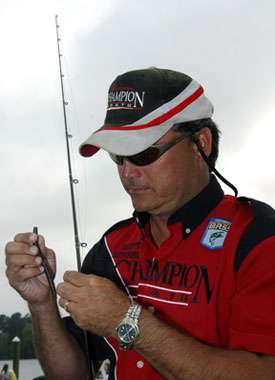
The final event in the 2009 Bassmaster Southern Opens should provide a real challenge for the anglers vying for the two Bassmaster Classic slots and seven Elite Series slots for 2010. Local anglers Ken Ellis (a tournament angler and guide) and Brett Mitchell (a tournament angler) predict it will only take an average weight of 10 pounds. per day to make the top 30 cut and just 13 to 17 pounds per day to win the event. These weights are significantly down from the 28.79 pounds-per-day average which Preston Clark sacked in the Elite Series event on Santee Cooper back in the spring of 2006.
Both Ellis and Mitchell predict that the lakes' water levels could be down 2 1/2 to 3 1/2 feet, making navigation in certain areas very challenging. Ellis thinks that high winds could make open areas of the lakes unfishable during at least one day of the event. He suggested that anglers be very careful running around the back sides of the islands in Marion, if they decide to fish in the diversion canal or in Lake Moultrie.
There are four primary patterns which Ellis believes might win the tournament. First, you can fish humps in the lower part of Lake Marion or in Lake Moultrie. Concentrate on the 6- to 7-foot depth range and look for stumps or brushpiles on these humps. Key baits for this pattern are a walking-type topwater, medium-depth crankbait and a heavy spinnerbait.
Second, a new pattern at Santee is fishing the eel grass, which has been recently introduced to the lake. There are vast stretches of this grass between Eutaw Creek and the mouth of the diversion canal. Ellis predicts that this new grass could play a major factor in the tournament. The baits he would use to fish the grass are a frog/toad style topwater or a swim jig.
Third, Ellis believes there could be a flipping bite in the area above the I-95 bridge in Lake Marion. He would concentrate on areas such as Jacks Creek and Stump Hole Swamp. The key cover in these areas is cypress trees with matted grass around them. This grass could be either water primrose/alligator grass or water hyacinths. The baits he would use around the trees are jigs and soft plastics.
Finally, the diversion canal could play a factor due to the constant current flow and the ever-present bait in the canal. Areas that generally hold bass are where the creek channels intersect with the canal and around the bridge in the center of the canal. Baits that should produce in the canal would be a walking type topwater early and a heavy white bucktail jig later in the day.
Mitchell thinks that there will be two potential tournament winning patterns going on in late October at Santee Cooper. First, fishing drains that feed into shallow water areas where there is bait present and, second, fishing eel grass edges. When fishing drains, he concentrates on the edges of the drains that have drops in depth from 6 to 10 feet with some type of wood cover on the edge of the drop. He finds the best drains in Lake Moultrie and in the lower part of Lake Marion. Mitchell works either a jig, Carolina rig or a medium running crankbait on the drops to catch the majority of his bass.
Mitchell feels the eel grass in the lower part of Lake Marion could play a major role in the tournament. When fishing the eel grass, he concentrates his efforts on the edges of the grass in 4 to 6 feet of water with frogs, floating worms and spinnerbaits.
The water level and how cold the water temperatures get will determine which pattern will be the primary one for the tournament. Mitchell believes that if the water remains hot and the lake levels are low, then the drain pattern will be the predominant pattern in the tournament. However, if the water cools quickly and the levels remain stable or rise, then the grass pattern could be a bigger factor.
Overall, the last event in the 2009 Bassmaster Southern Open series should be interesting. The winner will be the angler who can best overcome the navigational hazards and tough fishing conditions. But isn't it always a little like that? Whoever adapts best and fastest, wins.





